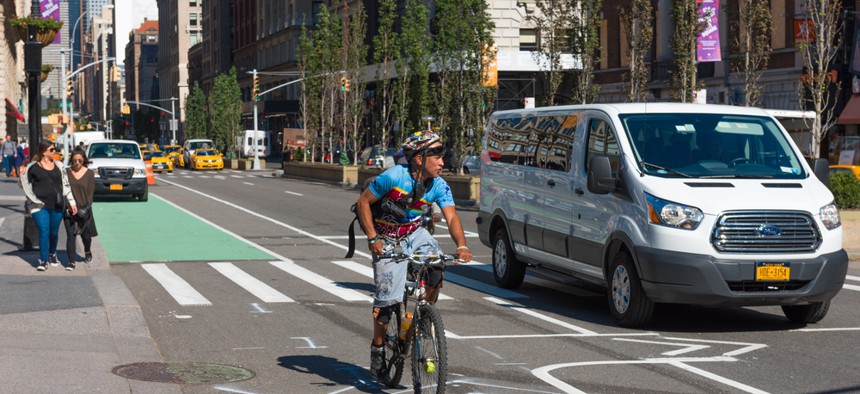A battle is being fought on New York City streets by cyclists, pedestrians and bus commuters challenging who want dedicated lanes and redesigned streets to put their needs on a more equal footing with those of drivers. Recently, after years of difficult battles with residents fearful of losing their parking spaces or traffic lines, those fighting car culture have won a few victories, including a new busway on 14th St. that bans passenger cars from 6 a.m. to 10 p.m., seven days a week.
But in light of the 25 fatalities of cyclists on city streets so far this year – the highest toll in two decades – “complete streets” advocates are fighting for transformational change. New York City Council Speaker Corey Johnson has got a plan for that, which passed in the City Council on Wednesday and is supported by New York City Mayor Bill de Blasio.
The bill would require the city Department of Transportation to implement a new transportation master plan every five years. The benchmarks proposed for the first five years are laid out in the bill and they prioritize pedestrians, cyclists and other non-driving commuters. While New York City’s taxis, Ubers, delivery trucks and SUVs aren’t going away anytime soon, alternative transportation advocates hope Johnson’s master plan will be a meaningful step in reclaiming street space that was gradually given away during the last century to the owners of private vehicles.
“We have lost too many people in our city – this year, last year, the year before, five years before that, 10 years before that – because of traffic violence, and because our streets have not been planned properly for all people who need to use them,” Johnson said on Wednesday.
Here are the key numbers behind the plan:
150: The bill calls for at least 150 miles of protected bus lanes to be created over five years, including at least 20 miles in the first year and 30 miles in the years following. Those bus lanes must be physically separated from other lanes or monitored by lane cameras.
250: Similarly, the plan gives the DOT five years to create 250 miles of protected bike lanes, meaning lanes that are separated from the road by physical barriers or are raised or off-road. The plan calls for at least 30 miles in the first year, and 50 in the years after that.
5: The plan in question is set to occur over a five-year period, starting in 2022. The legislation then requires that the DOT create a new master plan every five years.
13: De Blasio and the DOT are tasked with creating the five-year plan by Dec. 1, 2021. That gives the mayor and the DOT 13 months to figure out the specifics of the plan. After Johnson originally released his safe streets plan in March, de Blasio expressed concern about the bill’s timeline. Earlier this week, de Blasio announced his support of the amended bill with its pushed back deadline of Dec. 2021 – just one month before the mayor will leave office, having been term limited out. Implementing the plan will largely fall to the next mayor, who could end up being Johnson himself.
$1.7 billion: Johnson’s office estimates that the plan would cost to $1.7 billion over 10 years.
35-10-2: 35 City Council members voted to adopt the plan on Wednesday, with 10 members voting against, and 2 members abstaining.
1,250: The rough number of current bike lane miles in New York City. The City Council plan is ambitious in part because it will increase bike lane miles by 20% over the first five years.
100: De Blasio himself is responsible for creating 100 miles of the city’s current stock of protected bike lanes since 2014.
750: Apart from the creation of hundreds of new miles of bike and bus lanes, the master plan calls for implementing “transit signal priority” for at least 750 intersections in the first year, and 1,000 intersections annually for the following years. Transit signal priority technology allows traffic signals to be changed to green to speed buses up.
2,500: Over the first five years, pedestrian signals accessible to the visually impaired – non-visual WALK/DON’T WALK signals – must be installed for at least 2,500 intersections.
500: The number of bus stops that must receive upgrades – like covered benches and real-time passenger information – over five years.
1,000,000: By the end of 2023, the plan requires that 1,000,000 square feet of space be created and designed for pedestrians to enjoy, sidewalks and pedestrian plazas (think Times Square or Astor Place).


